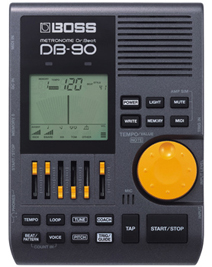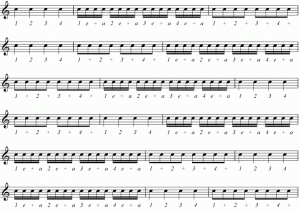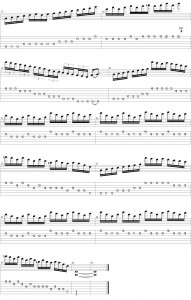If you are a half capable guitarist you’ve probably heard the words, “Play something really fast,” by your friends, and it’s usually meant as a challenge to test your chops. But what does playing something fast really mean? Is someone clocking the amount of time it takes you to play x amount of notes from point A to point B? And even if you’re moving at the speed of sound is that really a valuable skill as a guitarist, or more importantly, as a musician?
If you’ve ever listened to, or seen guitarists, that fall under the progressive rock, neoclassical metal, shred metal, or fusion categories such as Yngwie Malmsteen, Joe Satriani, Steve Vai, Andy Timmons, John Petrucci, Al Di Meola, Jason Becker, Michael Angelo Batio, Eric Johnson, Steve Morse, Michael Fath, Paul Gilbert, Buckethead and many others, you’ll know what your “friends” are challenging you to do, and its not easy.
So try this as a comeback if you’re ever in that scenario: “What do you mean by fast? Triplet scales at over 200 beats per minute ? Or sextuplets at 100 bpm? What about sweep picked 16ths at 180, or 8ths at 360, or even quarter notes at 720? What about right hand tapped 8ths with left hand triplet arpeggios? How about tremolo picked groups of 9?”
Now of course you’ll have to be able to perform these and be able to back this up with examples. But the point you’d be trying to get across is that everything has rhythmic subdivisions and that there are different contexts and techniques that enable speed. Being able to play something relatively fast with a groove or beat to it will have much more of an effect than the fastest blind lick in the world. Being able to do those examples consistently, under the pressure of the eyes and ears of other people, is a skill that has to be acquired with daunting amounts of practice. And ask 9 out of 10 professional guitarists and they’ll probably agree that the quickest way to play fast properly is to practice with a metronome.
So what is a metronome, why is it so important, and where can I get one?
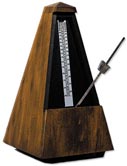
The first metronome was invented in 1812 by Dietrich Nikolaus Winkel. Today, you can find them everywhere, like your local music store and usually in vast supply. They’ll come in every shape and size imaginable with millions of other little bells and whistles like digital ones with tuners built in, analog ones with dials or pendulums, or even some in pedal formats.
They will all be relatively inexpensive, (unless they have more than a few functions,) and they will all perform that basic function of keeping a steady pulsing ‘sound,’ similar to the way a watch or clock keeps time with a second hand. They will have a wide range of tempos or the amount of sounds in a minute and the amount of time between them. Some will click; some will tick, and some will snap, crackle and pop.
Its exact function is to help a musician establish and internalize tempo in beats per minute. Before we get into what a good, reliable metronome is, let’s talk about what a metronome is not:
1) A metronome is not a drum machine.
If you’ve been practicing your scales and licks with a drum kit or synthesizer of some sort, it might be time to stop and get a metronome that has nothing more than a click-type sound. The reasoning here is the effect it will have on other aspects of your playing, such as your feel. Professional musicians have many personal, preferred synonyms that describe feel, such as groove, beat, jam, pulse, or flow. It is essentially your ability to tap your foot, bob your head, or dance and sway to a piece of music. The problem with using a drum-kit is that it gives you the groove without you having to feel it on your own. This is an intangible ability that all guitarists must be able to do by themselves and it’s a form of ear training to internally ‘hear’ the rhythm without there being one at all.
For instance, if you are jamming to a 4/4 swing feel (think every beat as a quarter note followed by an 8th under a triplet, or three eighth triplets minus the middle one) with a rhythm section, and the rhythm section was to cut out or stop suddenly, you should be able to hear, feel, and play with the beat as if it were still there.The drum machine gives you not only this, but a perfect, uninterrupted groove without you having to feel it on your own and does little to help your musical development. That said, it is recommended for beginners, especially those who do not have any experience with feel, to actually practice with a drum kit for a short time so they can develop a sense for what this means.
So, right now, test yourself, and see if you can just stand up and groove to a rhythm in your own mind. See if you can imagine a drum kit playing in your head and tap your foot, air drum to the rhythm or even full out dance. A good way to start practicing for this is to turn off the volume partially through a song you have gotten a feel for, letting the song continue in your head for a while, and then turning the song back on, seeing if you are still on the beat. If not, maybe it would be beneficial to go back and get some practice with a kit before moving on to a groove-less metronome.
2) A metronome is not a live, human drummer.
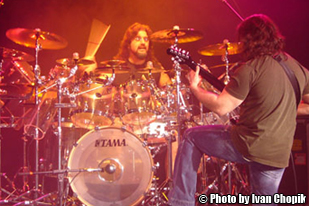
Mike Portnoy: A damn good human drummer
Remember, humans are well, human, and if you put them side by side to a machine, the machine will always win in terms of technique and timing, no matter the ability of the human. A very poor live drummer (not necessarily a beginner) can do you harm if he also has no sense of feel, and will throw you off by rushing or slowing down frequently. Now playing with a decent drummer, who can feel out a nice groove, is an invaluable asset, especially if he’s willing to practice along with you. Given the opportunity it’s recommended to play with a human drummer over a metronome or drum kit any day, especially if you are looking to perform with a band or ensemble.
The human element is the most complicated part about learning music and every chance you have to practice with other people is a golden opportunity to get your live chops up and strengthen your sense of communication with fellow musicians. However, when you’re attempting to purely practice building speed on particular exercises, a live drummer will usually not have the precision to change tempo in perfect increments and probably will not want to sit there for hours while you play the same scale over and over and over again. Remember, the whole point of playing with a metronome is so you can jump right back in with a band and play it with the rest of the band behind you.
3) A metronome will not develop your ear for pitch or your theoretical sensibility.
Make sure that when you practice you know what you’re practicing. Listen to the difference between an Aeolian (natural minor) scale and a Dorian minor. There is no point in developing the speed of the scales if you can’t hear the difference (such as the raised sixth degree in the Dorian) or know their place in a chord progression or solo. Learn your music theory! Getting fast without a solid foundation is a house of cards. You’ll be okay for a while, but you will only get so high in the industry before things don’t go so well.
4) A metronome will not make you into a Rockstar.
Just because you can play at a million miles an hour doesn’t mean everyone wants to hear it, especially in today’s music scene. Playing fast is contextual and a useful tool for musical expression. If you’ve ever heard the expression, “shred is dead,” you know that blazing guitar licks are not as popular in the contemporary music scene. Very few people will buy an album these days that is completely made-up of lightning fast riffs for over forty minutes. People will give it a listen for maybe three or four minutes and then turn it off. Learn how to use speed properly, write appropriate songs with good hooks and people will come back for more.
So what makes a good metronome?
A famous saying to familiarize yourself with is ‘K.I.S.S.’ or Keep It Simple Stupid. As a musician this saying has limitless applications, especially when dealing with buying potentially expensive gear. There are a lot of very popular and very reliable brand names out there that manufacture metronomes. To name a few: Korg, Boss, Yamaha, Seiko, Wittner, and Qwik Time. Ultimately you’ll want to find a metronome that can meet a number of personal requirements. Let’s look at some of the major differences between metronomes.
1) Volume.
This may be the single most important thing to consider when buying a metronome. Imagine all the possible scenarios within which you would use your metronome, such as with your electric or acoustic guitar, un-amplified or amplified, and clean or with distortion. Volume adjustments are nice features but, at least, at its maximum volume you should be able to hear it over your playing.
2) The sound of the click.
You’ll obviously want to get a sound that doesn’t drive you up a wall. You’ll have to get used to annoying sounds as a musician, but if you’re so distracted by the sound of the click that it’s making your practice session frustrating then it would be a good idea to find something else. As mentioned ealier, there are many types of sounds with many different textures such as clicks and snaps or thuds that emulate drum sounds. Once you’ve found one that you can at least bear, listen to if for a few minutes and see if it’s distinctive enough that you don’t tune it out by accident. The timbre or texture of the sound may be too soft or dull and cause you to drown it out.
3) Multiple sounds.
Some metronomes, especially the newer digital ones allow you to have varying sound files played instead of one single click. This is both a help and a hindrance. The most common use of this feature is playing a sharper attack on the 1 beat of every measure. It’s good to work on knowing where the 1 beat is without having the metronome reinforce it.
For example in a 4/4 time signature a classic metronome would sound like the following over two bars: Click Click Click Click, Click Click Click Click. A digital one with this feature would sound like: Pop Click Click Click, Pop Click Click Click. This is similar to having a drum kit more than a metronome. However when learning time signatures, which we’ll talk about later, it can be helpful to have the 1 Beat or other important beats, like 2, 4, 6, 7 etc in varying time signatures accented until you internalize them to the point where you can play along without them. Metronomes with the ability to turn on or off this ability will usually be a better choice.
4) Analog versus Digital.
This is another one of those never ending battles between analog and digital audio. Many people will swear by the natural sound of a classic popping or clicking metronome, and others will prefer the artificial sounds of the digital speakers, with the ability to adjust volume as well. In terms of function they are usually exactly the same, however many analog ‘pendulum’ style metronomes do not require batteries or a power source to run, just simply a little wind up crank.
5) Bells and whistles.
There are countless other features embedded in some of the newer metronome units. Sometimes it’s useful to have a tuner, headphone output and MIDI output if you need them or do not have other devices that work better. The Boss Dr. Beat line is considered one of the most advanced and powerful metronomes on the market.
Many professionals, however, swear by the rare classic Franz models, LM-FB or LM-FN model metronomes. It’s nothing more than a box that plugs into the wall with a dial on the front. It produces an electrified sharp click sound, and some models operate a pulsing light on the top. It does nothing more than repeat the same click at the set tempo but it’s a legend in metronome history and highly recommended if you can find one. We’ll continue under the assumption that you have nothing more complicated than something like this, (in terms of function) and we’ll get started on how to properly use your metronome.
Ultimately finding the right metronome will be up to you. Look for what you think will be most beneficial to you as a musician, and remember that any kind of metronome is better than no metronome. In the next installment we’ll take a look at sitting down and getting started by learning time signatures, rhythmic subdivisions and groupings of notes.
Make sure to check out the other installments of Learning to Use a Metronome Effectively.



